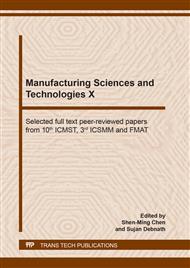p.3
p.8
p.18
p.23
p.28
p.36
p.43
p.49
Enhancing Mechanical Performance of Bagasse Fiber-Epoxy Composite by Surface Treatment
Abstract:
Surface treatment is one of the method used to enhance the mechanical performance of natural fiber composite by improving the compatibility of fiber and matrix. Nevertheless, no proof can be shown on which surface treatment is the absolute solution in improving the mechanical properties of natural fiber composite. Different surface treatments might have needed for different kinds of natural fiber composites. In this research work, water, alkaline, permanganate, bleaching and acetylation treatment on bagasse fiber are evaluated and the effect of soaking temperature as well as the effect of fiber loading are investigated. The mechanical performance of bagasse fiber-epoxy composite was studied by carrying out three-point bending test and optical microscopy test. Among 0w/w% and 5w/w% fiber loading, composite with 1w/w% and 2w/w% fiber loading possessed the highest flexural strength and modulus respectively. However, poor wettability between fiber and matrix was observed at higher fiber loading. Water, bleaching, permanganate and acetylation treatment have minor positive effect on the mechanical performance of the composite, yet a great increment in flexural properties of alkali treated fiber composite was noticed such that 21.48% and 23.95% of improvement was made on flexural strength and flexural modulus respectively. Optical microscopy test indicated that alkali treatment is responsible for roughening the fiber surface, and improving the fiber wettability and dispersion. Depend on the surface treatment, effect of soaking temperature may vary. In some treatments, hotter soaking temperature led to faster rate of reaction, which resulted in greater surface roughening and greater cleansing effect. Despite of that, over reaction can be happened in some cases, which will result in lower flexural properties due to over damaged fiber. Hence, it was concluded that the alkaline treatment at room temperature could be the most effective surface treatment to enhance the mechanical performance of bagasse fiber-epoxy composite.
Info:
Periodical:
Pages:
8-17
Citation:
Online since:
June 2020
Authors:
Keywords:
Price:
Сopyright:
© 2020 Trans Tech Publications Ltd. All Rights Reserved
Share:
Citation:


